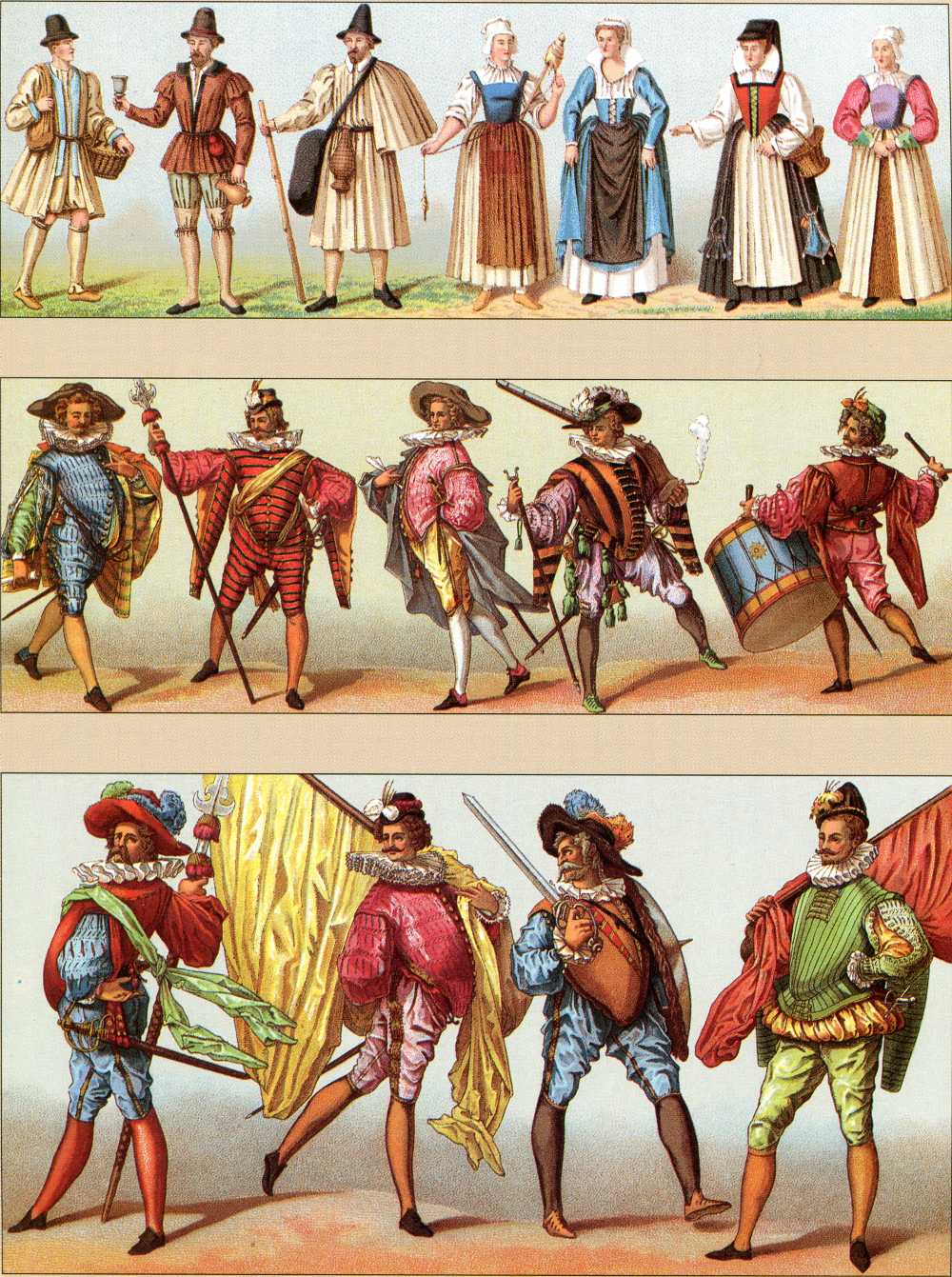
Shop Amazon - Create an Amazon Baby Registry
THE HISTORICAL ENCYCLOPEDIA OF COSTUME
ALBERT RACINET
THE CLASSIC WORK OF THE 19TH CENTURYp184-185

THE ILLUSTRATIONS AT THE TOP of the facing page show the costumes worn by working people in 16th-century France, during the reign of Henri III. The bottom two plates are illustrations of French infantry uniforms from the same period. Some experts have argued that these costumes in fact belong to Flemish soldiers, but there are enough similarities between the uniforms of the French and Flemish infantry for the details given below to serve as an adequate description of both.
1.1 A peasant from the neighbourhood of Saumur, wearing a felt hat with a turned-down brim, a sayon that goes down as far as mid-thigh level and a blue jerkin. He has a country-style coat, called a balandras, and is wearing gamashes to protect his legs from mud.
1.2 A wine seller in 1586, wearing a red-trimmed felt hat and a loose jacket with long basques that is gathered into the waist by a leather belt from which hangs a money bag. His breeches are narrow and his stockings are held up beneath the knee by garters. Men such as this wandered the streets of Paris in the mornings, offering wine to passers-by.
1.3 A shoeblack, wearing a large smock with a cape and stockings made of coarse wool. His huge leather bag is carried by means of a shoulder-strap.
1.4 A shepherdess from Anjou, wearing a cloth bonnet with a raised crown, a loose-sleeved blouse with a fluted collar, a blue bodice, braces and a woollen skirt.
1.5 A rich peasant woman wearing a décolleté blouse with a large, high collar, a bright blue surcoat, a white coat and a black apron.
1.6 A servant girl going to market in Paris in 1586. Her bonnet is covered with a cloth hood that hangs down the back as far as the belt, and she has a blouse with a high collar and a red bodice that is laced up at the front and trimmed with black velvet.
1.7 A chambermaid from Saumur wearing a bonnet from Anjou, as in 1.5, and a blouse that is gathered into the collar.
In 1574 and 1579, Henri III ruled that only infantry company commanders could wear tabards and breeches made of gold and silver material or silk on silk. Apart from this, and their possession of a baton, there was nothing to distinguish officers from men.
There was no rigid uniform, and it was considered quite permissible to mix colours, with stockings of one colour and breeches of another. Infantry soldiers often sported as many as eight or 10 colours.
While ladies wore busks in order to flatten the stomach, soldiers of this period wore devices known as panserons, which had the opposite effect. This gave the flamboyant French and Flemish soldiers the appearance of bully boys - apparently felt to be desirable at this time.
The doublet, with or without sleeves and slashes, was adjusted to fit over the panseron. Breeches could be tight or baggy going down to just below the knee, but codpieces were now not worn.
A puckered collar or ruff rose out of the doublet. Headgear consisted of a toque or a Spanish-style sombrero with a plume.
Soldiers wore sashes as a personal token, but their rallying point was the company's flag. This was made of silk, and was often so large that it had to be held up to prevent it from dragging along the ground. Drums, too, were enormous and awkward to carry, but military cloaks were surprisingly small, barely going past the knees.
